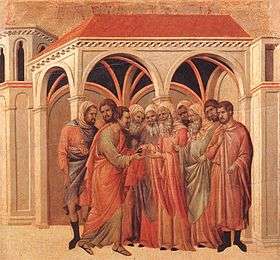Bargain of Judas


The Bargain of Judas is a biblical episode related to the life of Jesus that appears in all three Synoptic Gospels, Matthew 26:14–16, Mark 14:10–11 and Luke 22:1–6. It relates how Judas Iscariot made a bargain with the chief Jewish priests to betray Jesus.[1]
The Gospel of Matthew specifies that Judas received thirty pieces of silver:
Then one of the Twelve—the one called Judas Iscariot—went to the chief priests and asked, "What are you willing to give me if I hand him over to you?" So they counted out for him thirty silver coins. From then on Judas watched for an opportunity to hand him over.[2]
The Gospel of Mark and the Gospel of Luke mention no price. The Gospel of Luke states that Satan entered Judas to prompt him for the bargain:
Now the Feast of Unleavened Bread, called the Passover, was approaching, and the chief priests and the teachers of the law were looking for some way to get rid of Jesus, for they were afraid of the people. Then Satan entered Judas, called Iscariot, one of the Twelve. And Judas went to the chief priests and the officers of the temple guard and discussed with them how he might betray Jesus. They were delighted and agreed to give him money. He consented, and watched for an opportunity to hand Jesus over to them when no crowd was present.[3]
In the New Testament Jesus is later betrayed in the Kiss of Judas incident. The Bargain of Judas is considered one of the seven key episodes that relate to the events of the week of the Crucifixion of Jesus.[4]
See also
| Wikimedia Commons has media related to Pact of Judas. |
- Chronology of Jesus
- Gospel harmony
- Jesus predicts his betrayal
- Kiss of Judas
- Life of Jesus in the New Testament
Notes
- ↑ All the Apostles of the Bible by Herbert Lockyer 1988 ISBN 0-310-28011-7 pages 106–111
- ↑ Biblegateway
- ↑ Biblegateway
- ↑ The Synoptic Gospels and the Book of Acts by Doremus Almy Hayes 2009 ISBN 1-115-87731-3 page 88